
The advent of artificial intelligence (AI) in education is not merely a shift but a revolutionary transformation, reshaping the landscape of how educational content is delivered, absorbed, and assessed on a global scale.
According to Allied Market Research, the global AI in education market is estimated to reach $88.2 billion by 2032. It is undeniably accelerating at an unprecedented pace. This significant uptrend highlights AI's critical role in personalizing learning experiences, enhancing student engagement, and optimizing assessment processes.
Our comprehensive report dives deep into the multifaceted role of AI in education, aiming to uncover its expansive scope, definitive purpose, innovative methodologies, and the inherent challenges it presents.
Furthermore, we explore strategies for augmenting AI to address these challenges effectively, ensuring that its integration into educational systems is both productive and ethical.
In this report, we combine insights from a diverse group of lifelong learners of Skill Success, one of the top online learning platforms, with expert opinions from more than 300 professionals in the field of AI and education. This mix gives us a unique and comprehensive look at how AI is changing education, highlighting the best ideas and biggest challenges from a wide range of perspectives.
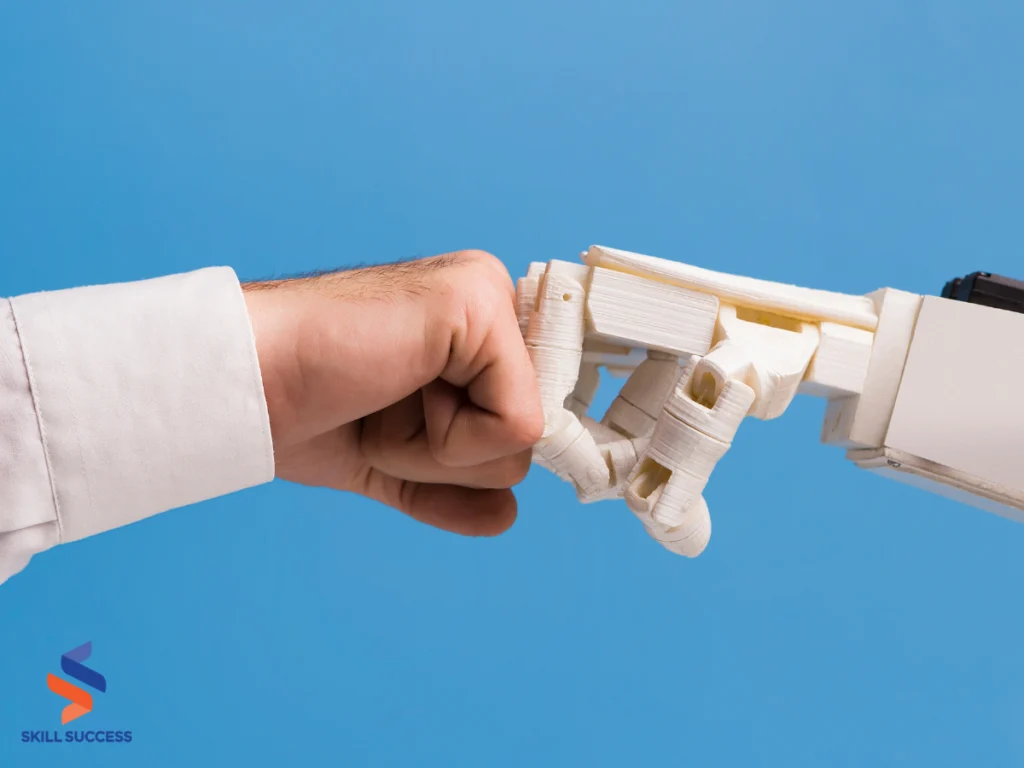
Understanding AI in Education
AI refers to the simulation of human intelligence in machines that are programmed to think like humans and mimic their actions. In educational contexts, AI facilitates a personalized, accessible, and efficient learning experience, extending its reach globally and enhancing student engagement.
This is pivotal in transforming education, aiming to innovate practices and contribute towards achieving Sustainable Development Goal 4 (SDG 4). UNESCO champions the use of AI to fulfill the Education 2030 Agenda, emphasizing a human-centered approach that promotes inclusion, equity, and prevents widening technological divides.
To provide a more in-depth exploration of the key technologies underpinning AI in education, let's talk about Machine Learning (ML) and Natural Language Processing (NLP), among others, highlighting their applications, challenges, and potential impacts on the educational landscape.
1. Machine Learning (ML) in education
Applications:
- Personalized learning: ML algorithms analyze data on students' learning styles, performance, and preferences to tailor educational content, pacing, and learning paths, offering a customized learning experience for each student.
- Automated grading: By training on thousands of student-submitted assignments, ML can provide instant feedback and grading, freeing educators to focus on teaching and personalized interaction.
- Predictive analytics: ML can predict student performance, identify at-risk students, and recommend interventions to improve outcomes, thereby reducing dropout rates and enhancing academic success.
Challenges:
- Data privacy and security: The use of student data raises concerns about privacy and the need for robust data protection measures.
- Bias and fairness: ML models can inherit biases present in their training data, potentially leading to unfair outcomes for certain student groups.
- Integration with existing systems: Seamlessly integrating ML-driven tools with current educational software and practices requires time, resources, and training.
C.L. Mike Schmidt offers this advice.
“To safeguard student privacy, strong data protection policies should be in place. Schools and institutions should be crystal clear about what data they're collecting, why they're collecting it, and how it's going to be used. Transparency is key. Nobody likes surprises, especially when it comes to their personal information. By laying out these policies in plain language and ensuring everyone understands them, we're building a foundation of trust. Students, parents, and educators should feel confident that their data is being handled responsibly. We've also got to prioritize data encryption. You see, we're living in a world where cyber threats are like sneaky ninjas. Encrypting the data is like giving it a super shield. It makes it way harder for anyone with malicious intent to get their hands on sensitive information. Encryption scrambles the data into an unreadable format without the proper decryption key, making it virtually impossible for unauthorized users to decipher it. It's like locking your valuables in a safe – an essential step in keeping them secure.”
Jon Morgan shares how regular audits can also help mitigate the challenges when it comes to AI in education.
“Regular audits are like the security guards of the operation. We need to periodically check how things are going, ensuring that everyone is playing by the rules. If there are any loopholes, let's patch them up pronto. Audits help identify potential vulnerabilities or compliance gaps, allowing us to take corrective action before they escalate into bigger problems. By conducting thorough and regular assessments of our data practices, we can stay one step ahead of emerging threats and maintain a strong defense posture.”
2. Natural Language Processing (NLP) in education
Applications:
- Language learning: NLP technologies support language learning by providing real-time feedback on pronunciation, grammar, and vocabulary usage, facilitating immersive and interactive language acquisition experiences.
- Content analysis: NLP can analyze and summarize educational content, making it easier for educators to curate and adapt materials to suit diverse learning needs.
- Intelligent tutoring systems: These systems use NLP to understand and respond to student queries in natural language, offering personalized guidance and support.
Challenges:
- Understanding context: NLP systems sometimes struggle to grasp the nuances of human language, including sarcasm, idioms, and context-dependent meanings, which can lead to misunderstandings.
- Language diversity: Creating NLP systems that support a wide range of languages and dialects is challenging, potentially limiting access for non-English speakers or those speaking less common languages.
- Continuous learning: Language evolves, and NLP systems must continuously learn from new data to remain effective, requiring ongoing maintenance and updates.
3. Emerging technologies
Beyond ML and NLP, emerging technologies such as Augmented Reality (AR) and Virtual Reality (VR), Blockchain, and Educational Data Mining (EDM) are also shaping the future of education.
- AR and VR offer immersive learning experiences, making complex subjects more accessible.
- Blockchain can secure student records and credentials, enhancing transparency and trust.
- EDM uncovers insights from educational data, informing policy and practice.
Evolution of AI in Educational Contexts
The evolution of AI in educational contexts is a fascinating journey marked by rapid advancements and transformative innovations.
This progression has fundamentally altered the landscape of education, transitioning from rudimentary programmed instructions to sophisticated algorithms that offer highly personalized learning experiences and provide deep, data-driven insights into student performance.
Initial stages: Programmed instructions and computer-assisted learning
Early 1960s to Late 1970s:
The genesis of AI in education can be traced back to the development of computer-assisted learning programs. These early systems were rudimentary, focusing on drill-and-practice methods without customization or adaptability.
Examples: PLATO (Programmed Logic for Automatic Teaching Operations) system, which offered basic educational software and tools for students and educators.
The emergence of adaptive learning systems
Late 1970s to 1990s:
A significant leap was the introduction of adaptive learning systems. These systems marked the early attempts to tailor educational content to individual learner's needs based on their responses.
Advancements: The application of simple rule-based algorithms allowed these systems to adjust the difficulty level of tasks in real-time, offering a somewhat personalized learning experience.
The rise of Intelligent Tutoring Systems (ITS)
1990s to Early 2000s:
The development and implementation of Intelligent Tutoring Systems (ITS) represented a major milestone. These systems combined rule-based programming with early forms of machine learning to offer more nuanced educational experiences.
Features: ITS could model student knowledge, predict potential misunderstandings, and provide customized feedback, significantly improving the effectiveness of digital learning.
Integration of Machine Learning and Natural Language Processing
Early 2000s to 2010s:
The integration of Machine Learning (ML) and Natural Language Processing (NLP) technologies marked the next phase of evolution. These technologies enabled the development of more sophisticated and responsive educational tools.
Capabilities: With ML and NLP, educational software could understand and process natural language inputs, provide more personalized feedback, and adapt learning paths based on comprehensive data analysis.
The current era: Advanced analytics, big data, and personalization
2010s to Present:
The current era of AI in education is characterized by the use of advanced analytics, big data, and deep learning algorithms. These technologies enable unprecedented levels of personalization, engagement, and efficiency in learning.
Innovations: The application of AI now extends beyond individual learning experiences to include predictive analytics for student success, automated essay scoring, and even the management of administrative tasks.
Impact: AI-driven platforms and tools can now identify gaps in knowledge, recommend resources, and even predict student performance with significant accuracy, thereby enabling targeted interventions.
Future directions: Ethical AI, augmented reality, and beyond
Looking Ahead:
The future of AI in education promises even greater integration of augmented reality (AR), virtual reality (VR), and ethical AI frameworks. These advancements aim to create immersive and equitable learning environments that cater to diverse learning styles and needs.
Challenges: As AI continues to evolve, addressing ethical considerations, ensuring data privacy, and reducing biases in AI algorithms will be paramount to harnessing its full potential in educational settings.
As AI continues to evolve, staying informed about its applications, ethical considerations, and potential impacts is essential for educators, students, and policymakers alike, ensuring that education remains accessible, engaging, and effective for all learners.

Leading AI-Powered Applications in Education
Here are the leading AI-powered applications that are transforming educational practices by offering personalized, adaptive, and innovative learning solutions.
- Knewton: Now part of Pearson, Knewton offers adaptive learning technology that personalizes educational content to meet the individual needs of students, helping them to focus on areas where they need improvement.
- Duolingo: This popular language-learning app uses AI to personalize lessons for each user. Its AI algorithms adjust the content, predict words that users might struggle with, and tailor lessons accordingly to optimize learning efficiency.
- Carnegie Learning: Specializing in math education, Carnegie Learning’s software uses cognitive science and AI technologies to provide personalized math learning experiences and real-time feedback to students.
- ALEKS (Assessment and LEarning in Knowledge Spaces): An AI-based online learning system that uses adaptive questioning to quickly and accurately determine what a student knows and doesn't know in a course, then instructs the student on the topics they are most ready to learn.
- Grammarly: While not exclusively for educational institutions, Grammarly uses AI to improve writing skills, offering suggestions on grammar, punctuation, style, and even the tone of the writing, making it a valuable tool for students and educators alike.
- Squirrel AI Learning: This adaptive learning platform provides personalized instruction and feedback to students, particularly in K-12 education, helping to identify knowledge gaps and tailor the learning experience to each student’s needs.
- Quizlet: Known for its learning flashcards, Quizlet uses AI to create personalized study paths for users, helping them to study more efficiently by focusing on concepts they haven’t mastered.
- EdTech Foundry’s Differ: This chatbot app facilitates student engagement by creating community and dialogue in large educational settings, using AI to drive personalized interactions and support.
- Brainly: As a peer-to-peer learning platform, Brainly uses AI to moderate content, ensure question quality, and tailor students' learning experiences by providing them with customized assistance from peers around the world.

Survey Results: AI in Education
To understand the community's perspective on AI in education, we conducted a survey to assess their knowledge and views. This effort helps us determine if there's a need to educate the public further on AI's pros and cons in educational settings.
By exploring the insights of our respondents, we aim to identify knowledge gaps and promote a more informed conversation about AI's role in education.
1. How familiar are you with the concept of AI in education?
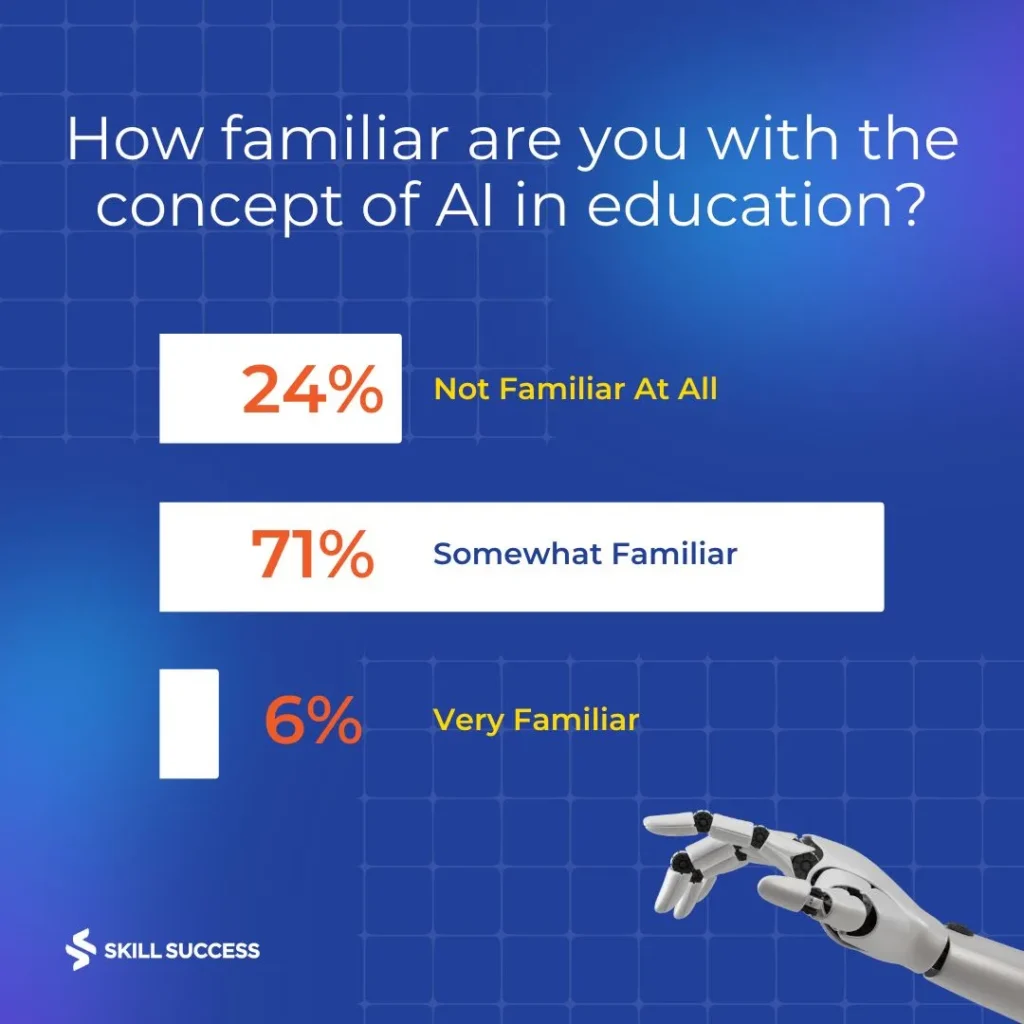
Regarding the concept of AI in education, a survey reveals varying levels of familiarity among respondents. A small fraction, 24%, indicated they are not familiar at all with AI's application in educational settings. The majority, representing 71%, consider themselves somewhat familiar, suggesting a basic understanding or awareness of the topic. Only a slim 6% of the participants professed to being very familiar with AI in education, implying a deep knowledge or extensive experience with this technology's integration in learning environments.
2. Do you believe AI can be effective in personalizing learning for students?
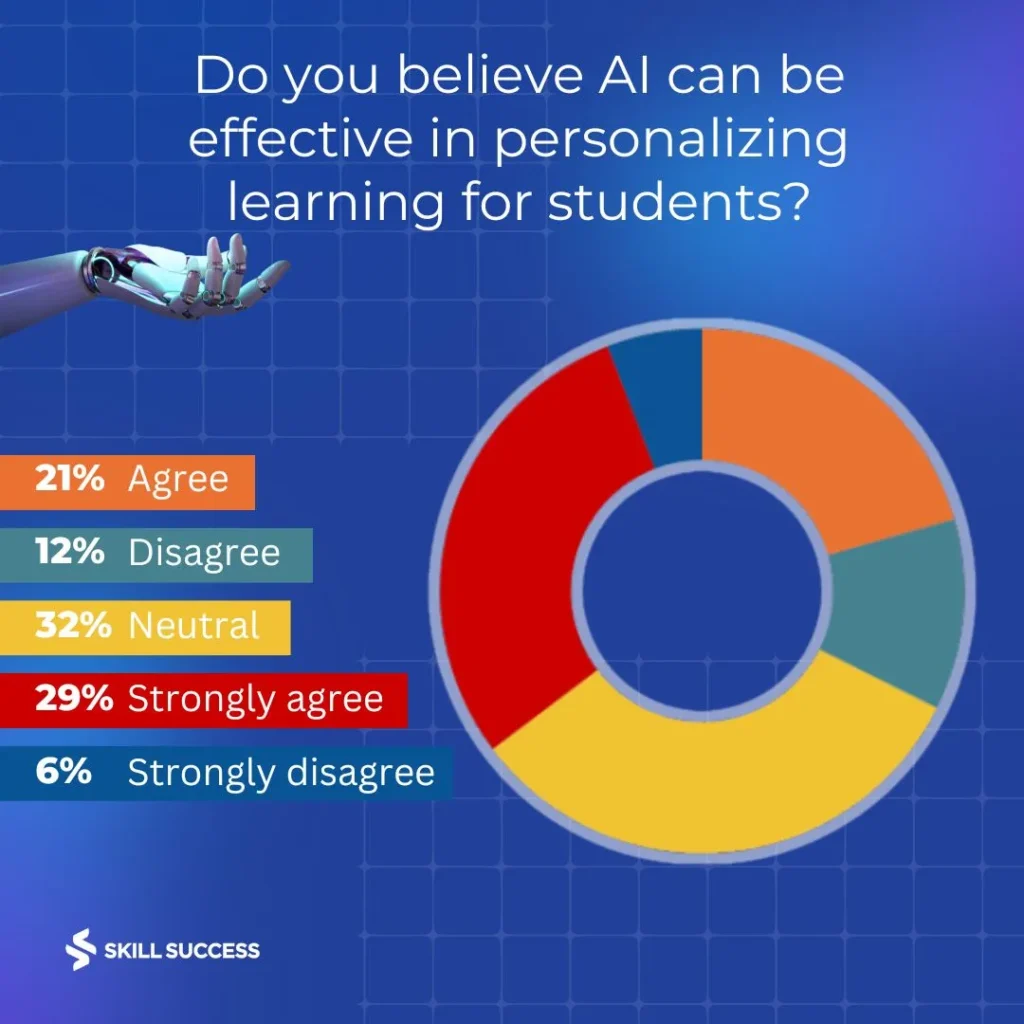
The survey on the effectiveness of AI in personalizing learning for students yielded a diverse set of opinions among respondents. A total of 21% agreed that AI has the potential to tailor learning experiences effectively, suggesting a positive outlook towards the technology's capabilities. Conversely, 12% disagreed, expressing skepticism about AI's efficacy in this domain. A significant portion, 32%, remained neutral, indicating either uncertainty or a wait-and-see attitude towards AI's impact on personalized learning.
Notably, a slightly larger group, 29%, strongly agreed with the premise, showcasing a robust confidence in AI's ability to customize education. On the other end, a small minority of 6% strongly disagreed, highlighting a strong skepticism or opposition to the idea. These responses reflect a wide range of beliefs about the role and effectiveness of AI in making learning more personalized for students.
3. Do you think the increasing dependence on technology in education poses any risks or challenges?
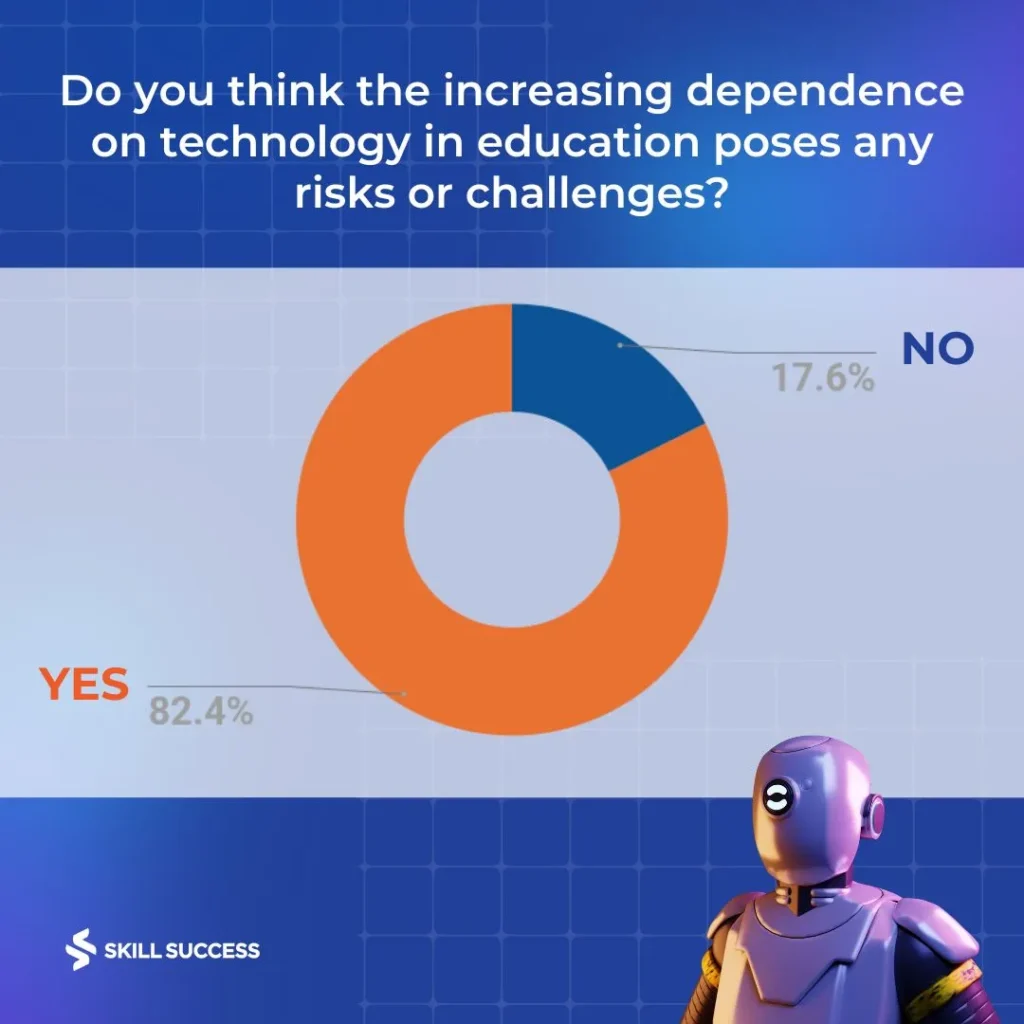
A majority, 82%, recognized significant risks or challenges with the growing dependence on technology in education, pointing to issues like data privacy, the digital divide, and impacts on learning and social skills. In contrast, 18% perceived no substantial risks, indicating a belief in the benefits of technology integration outweighing potential drawbacks.
4. In your opinion, what measures should be taken to prevent or detect cheating facilitated by AI in education?
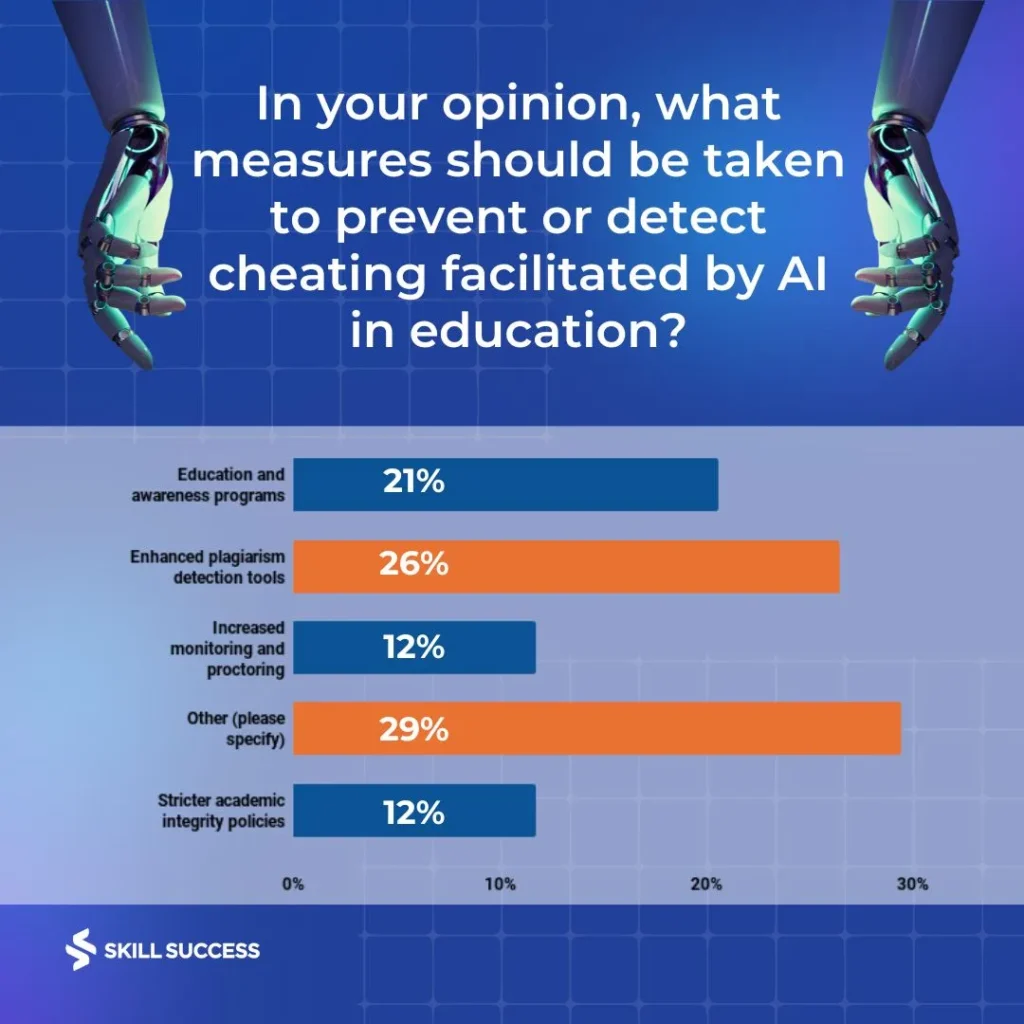
To counteract cheating facilitated by AI in education, respondents favored diverse measures:
- 21% recommended education and awareness programs to address the issue, highlighting the importance of informing students and faculty about the ethical use of AI.
- Another 26% advocated for enhanced plagiarism detection tools, suggesting a technological approach to identifying and preventing academic dishonesty.
- Increased monitoring and proctoring, and stricter academic integrity policies, each received 12% support, indicating a preference for more traditional methods of deterrence and enforcement.
- Notably, 29% suggested other unspecified measures, reflecting a belief in the need for innovative or alternative solutions to effectively tackle AI-facilitated cheating.
Furthermore, C.L. Mike Schmid offers the following insights:
“When used ethically and transparently, I believe AI can be a valuable tool. For example, using AI for data analysis, literature reviews, or complex computations can improve the efficiency and accuracy of research. However, it is essential to recognize the significance of proper citation and attribution when using AI-generated content. Researchers ought to take responsibility for understanding and validating AI results, ensuring that the technology is used as a supplement to human intelligence rather than a shortcut to bypass academic rigor.”
Additionally, It's essential to make sure that students clearly understand your school's specific definition of cheating. Don't presume they already know; explicitly outline your institution's honor code, emphasizing the guidelines on AI technology use, through diverse methods such as the syllabus, workshops, orientation sessions, or online learning modules. A comprehensive approach to fostering awareness and comprehension will better equip students to adhere to the principles of academic integrity.
5. In your opinion, what steps should be taken to prepare for the future of AI in education?
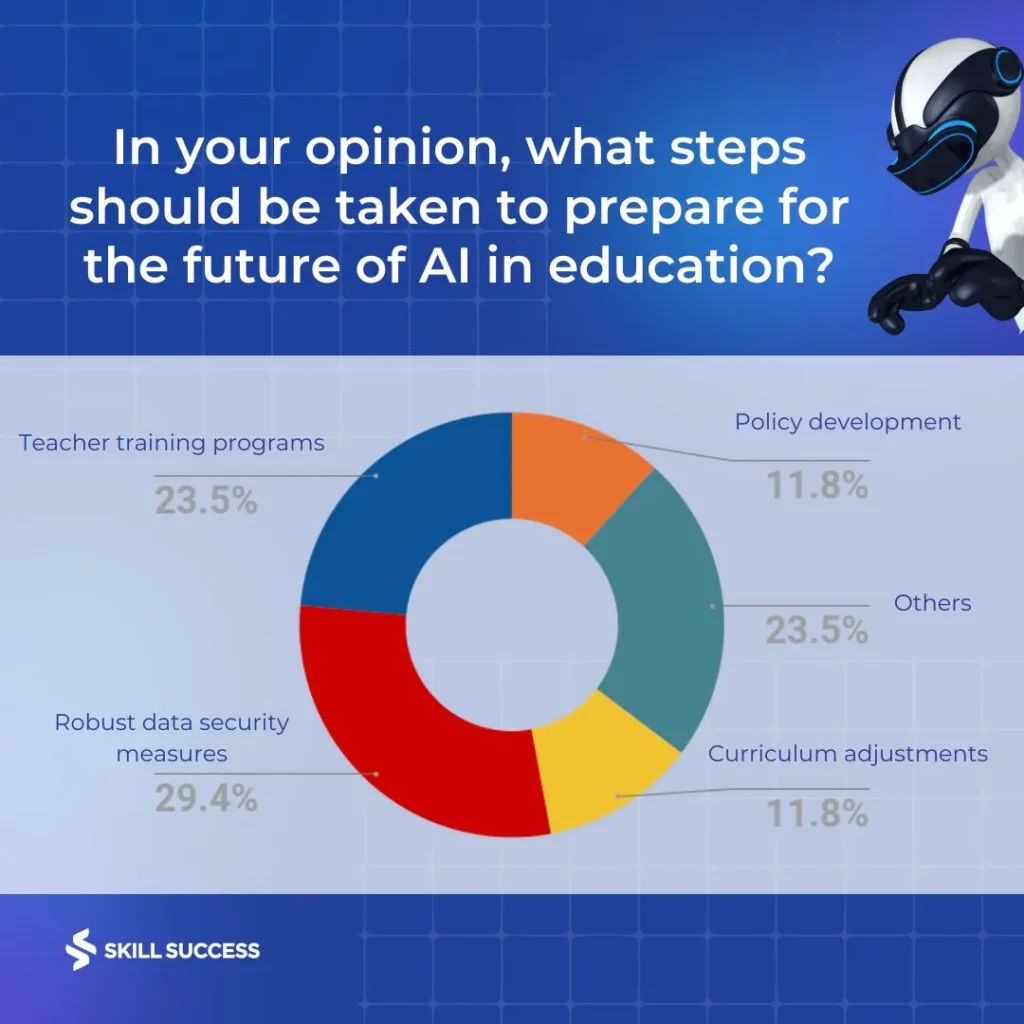
To prepare for the future of AI in education, respondents highlighted several key steps:
- 12% suggested curriculum adjustments to incorporate AI knowledge and skills, reflecting the need for educational content to evolve with technological advancements.
- An equal percentage, 12%, pointed to the development of policies to govern the use and implications of AI in educational settings.
- The largest share, 29%, emphasized the importance of robust data security measures, indicating concerns about privacy and the protection of student information.
- Additionally, 24% advocated for teacher training programs, underscoring the need to equip educators with the skills to effectively integrate AI tools in teaching and learning.
- Another 24% provided various unspecified recommendations, suggesting a wide range of additional considerations for effectively embracing AI in education.
Impact of AI on Learning Outcomes
Fortunately, a lot of academic experts believe that the integration of Artificial Intelligence (AI) into the educational landscape represents a transformative shift with far-reaching implications for enhancing learning outcomes.
1. Personalized learning experiences
One of the most significant advantages of AI in education is its ability to offer personalized learning experiences.
Traditional educational models often adopt a one-size-fits-all approach, which can overlook the unique needs, learning paces, and preferences of individual students. AI, through adaptive learning technologies, can analyze a student's performance, strengths, and weaknesses in real-time. This analysis enables the creation of customized learning paths and materials tailored to each student's specific needs, thereby enhancing learning efficiency and outcomes.
- Adaptive learning platforms: These platforms use AI to adjust the difficulty level of tasks based on the student's performance, ensuring that each student is challenged appropriately, not overwhelmed or bored.
- Feedback and assessment: AI can provide instant feedback to students, identifying errors and offering corrections or suggestions for improvement. This immediate response helps students learn from their mistakes in real time and solidifies their understanding of concepts.
2. Accessibility in education
AI technologies have made education more accessible to a wider range of learners, including those with disabilities or those living in remote areas. By breaking down physical and logistical barriers, AI ensures that high-quality education is available to anyone with internet access.
- Voice assistants and translators: These tools can help non-native speakers and students with hearing or speech impairments to participate fully in educational settings.
- Visual assistance technologies: For visually impaired learners, AI-driven applications can translate text into speech or braille, making written materials more accessible.
3. Engaging learning environments
AI contributes to the creation of more engaging and interactive learning environments. Traditional lecture-based teaching methods can sometimes fail to capture students' attention, leading to disengagement. AI, however, can introduce novel and interactive elements to education that cater to the digital-native generation.
- Gamification: By incorporating elements of game design into learning activities, AI can make education more engaging. This approach not only increases student motivation but also enhances learning retention.
- Virtual Reality (VR) and Augmented Reality (AR): These technologies create immersive learning experiences, allowing students to explore historical events, scientific phenomena, and complex concepts in a hands-on manner. This direct engagement deepens understanding and retention.
4. Improved efficiency in administrative tasks
AI streamlines administrative tasks such as grading, scheduling, and student inquiries through automation and intelligent processing. This not only reduces the workload on educators but also speeds up response times, allowing for more focus on teaching and student interaction.
“Teachers are constantly reinventing the wheel. AI can save teachers HOURS of work every week in email communication, individualized and tailored worksheet creation or differentiation, marking and report writing. Teachers who refuse to embrace it are creating a rod for their own back - and disadvantaging their students. Ignoring AI is akin to the teachers of yesteryear who refused to embrace computers…”
5. Broader global reach
Online learning platforms powered by AI can cater to a global audience, breaking down geographical and socio-economic barriers to education. AI-driven analytics can also help tailor content to cultural and regional specifics, making learning more relevant and engaging across different populations.
“AI in education offers significant potential for diverse learners, especially those with ADHD, autism, and dyslexia, providing personalized learning experiences suited to their needs. Integrating AI alongside traditional teaching methods to foster critical thinking, and deeper learning engagement is vital, rather than supplanting them entirely. AI can aid in idea generation and refinement, aiding written and verbal expression, which is particularly advantageous for non-verbal communicators. As someone who is neurodivergent and serves as the director of the National Autism Directory, Living on the Spectrum, I've witnessed remarkable advancements in accessibility and learning opportunities utilizing AI for a wide range of learners, including myself.”

Skill Success Expert Insights
Within our organization, we recognize the transformative potential of AI in education, along with the concerns it raises, both as educators, professionals, and parents. To better understand the diverse perspectives on this topic, we've gathered insights from experts within our team, who share their views on the integration of AI into learning environments from both a professional standpoint and personal experience. Their reflections highlight the nuanced balance between leveraging technology to enhance education and maintaining traditional learning values. Here's what they had to say:
1. Cath Garcia CPHR, HR & Recruitment Manager
“I believe that in every technology there are pros and cons. It's only up to you to mitigate it or ensure to minimize the cons. AI has been widely adapted and has made a mark on the new trends. For me, AI in education is good if it will be used in the right way. It helps the learners widen their knowledge as it is another way of researching and learning further. However, if it will be used for cheating and plagiarism then that's what I think will cross the line. There should still be a balance of learning from it rather than copying it.”
2. Joanne Ocate, CS Team Lead
“AI is undoubtedly changing and shaping our education. I believe that AI has a positive effect on our education. I think the main advantage of AI is it generates learning materials based on each learner's specific needs. The topics/subjects can be personalized based on the learner’s ability and can progress at their own pace. Another benefit is AI is flexibility and accessibility, it can be accessed anytime, anywhere, even those with disabilities. Lastly, the simplified methodologies. It is now easier to understand complicated problems.”
3. Barbara Isla, Content Writer
“At first, the idea of AI in my kids' lives made me nervous. I worried it might dull their sharp little minds. But then, watching AI help them like a personal tutor, teaching them efficiency and new ways of learning, I started to see the light. Yet, I can't shake the belief that kids still need a mix of old and new. So, as a mom and perhaps what any educator might think, it's crucial to remind our children about the value of digging deep into research and not leaning too heavily on tech. Imagine bringing back some old-school charm, like writing essays by hand. It's these kinds of activities that stretch their creativity and critical thinking muscles—skills I believe are fundamental for growing strong characters.”
Applications of Artificial Intelligence in Educational Settings
Let's delve deeper into how AI technologies are revolutionizing curriculum development and content delivery:
Adaptive learning systems
Adaptive learning systems use AI to personalize the learning experience for each student. By analyzing students' responses and learning patterns, these systems adjust the curriculum in real-time, providing more challenging material for quick learners and additional support for those who need it. This personalization ensures that all students can learn at their own pace, making education more effective and efficient.
AI tutors
AI tutors are AI-powered platforms that simulate one-on-one tutoring sessions. They can offer instant feedback, answer questions, and guide students through complex concepts at any time of the day. This accessibility helps students get the help they need outside the traditional classroom setting, enhancing their understanding and retention of the material.
Gamification techniques
Gamification incorporates game design elements into learning to make education more engaging and motivating. AI enhances these techniques by creating personalized learning adventures, adapting challenges to the learner's level, and providing rewards and feedback that are tailored to the individual's progress. This approach makes learning more enjoyable and can significantly improve student engagement and motivation.
Virtual/Augmented Reality (VR/AR) applications
VR and AR applications provide immersive learning experiences that are not possible in a traditional classroom. With AI, these experiences can be customized to suit the learner's preferences and educational needs, offering hands-on practice in a virtual environment. For example, medical students can perform virtual surgeries, while history students can explore ancient civilizations in 3D. These realistic simulations enhance learning by providing practical experience and contextual understanding.
AI Course Recommendations
We recommend a selection of courses designed to broaden your understanding of AI's principles, its diverse applications, and its potential to reshape not just education but various facets of our lives and work. These courses are tailored to empower educators, professionals, and parents with the knowledge and tools to navigate the AI landscape thoughtfully and effectively.
- How to Supercharge Your Life and Work with Bing AI Chatbot
- ChatGPT Masterclass: The Complete Guide to Using ChatGPT
- ChatGPT, Midjourney And DALL-E Essentials: AI 3 in 1 Course
- DALL-E 3 Complete: Master AI Art Generation with DALL-E 3
- The New Bing AI Tutorial for Complete Beginners
- Introduction to the Latest Artificial Intelligence Tools
- Future Artificial Intelligence Reinforcement Learning
- ChatGPT Masterclass: A Complete ChatGPT AI Training Guide
- Deep Artificial Intelligence From A-Z
Artificial intelligence is not confined to the realm of education as highlighted in Rongzhong Li’s insight.
“AI facilitates communication, streamlines processes, and enables access to vast amounts of information. From businesses optimizing operations to individuals connecting globally, IT empowers efficiency, innovation, and collaboration. Its role in driving economic growth, enhancing healthcare, and advancing education underscores its importance in shaping the modern world. In essence, information technology serves as the backbone of modern society, driving progress and transformation in virtually every aspect of our lives.”
Frequently Asked Questions
1. What is AI in Education?
AI in Education refers to the integration of artificial intelligence technologies into educational environments to personalize learning, automate administrative tasks, and provide insights into the learning process through data analysis.
2. How can AI personalize learning for students?
AI can tailor learning experiences to individual students' needs by analyzing data on their learning habits, strengths, and weaknesses. It can adjust the difficulty level of tasks, recommend resources, and create personalized learning pathways.
3. What are the benefits of AI in Education?
Benefits include personalized learning experiences, increased efficiency in administrative tasks, improved accessibility for students with disabilities, enhanced engagement through interactive tools, and data-driven insights for educators to improve teaching strategies.
4. What are some examples of AI applications in Education?
Examples include intelligent tutoring systems, virtual learning assistants, automated grading systems, AI-driven content recommendation engines, and predictive analytics tools for tracking student performance.
5. Can AI replace teachers?
AI is not meant to replace teachers but to augment the educational process. It can handle repetitive tasks and provide personalized learning insights, allowing teachers to focus more on critical aspects of teaching, such as fostering emotional and social skills.
6. How does AI impact students with special needs?
AI can greatly benefit students with special needs by providing customized learning tools and content, speech-to-text capabilities, personalized learning experiences, and adaptive assessments that cater to their unique learning requirements.
7. What are the ethical considerations of using AI in Education?
Ethical considerations include ensuring data privacy and security, preventing biases in AI algorithms, maintaining transparency in AI-driven decisions, and ensuring that the use of AI does not widen the digital divide.
8. How does AI affect the role of educators?
AI transforms educators' roles by automating administrative tasks and providing insights into student performance, allowing educators to focus more on pedagogy, student engagement, and addressing individual learning needs.
However, while teachers generally hold a positive view of AI in education, with 50% feeling excited or optimistic, a significant 70% report receiving no formal guidance on leveraging AI effectively.
9. What challenges are associated with implementing AI in Education?
Challenges include the high cost of technology, the need for digital infrastructure, ensuring data privacy, the risk of reliance on technology over human judgment, and the potential for technology to perpetuate biases.
10. What is the future of AI in Education?
The future of AI in Education includes more adaptive and intelligent learning environments, increased use of virtual and augmented reality for immersive learning, more robust data analytics for informed decision-making, and greater collaboration between AI and educators to enhance learning outcomes.

Key Takeaways
Statistics on AI Education
Familiarity with AI in education:
- 24% not familiar at all
- 71% somewhat familiar
- 6% very familiar
Belief in AI's effectiveness for personalization:
- 21% agree AI can effectively personalize learning
- 12% disagree
- 32% neutral
- 29% strongly agree
- 6% strongly disagree
Risks of technology dependence in education:
- 82% recognize risks/challenges (e.g., data privacy, digital divide)
- 18% see no substantial risks
Measures against AI-facilitated cheating:
- 21% education and awareness programs
- 26% enhanced plagiarism detection tools
- 12% increased monitoring and proctoring
- 12% stricter academic integrity policies
- 29% other unspecified measures
Preparation for AI's future in education:
- 12% curriculum adjustments for AI knowledge/skills
- 12% development of AI governance policies
- 29% robust data security measures
- 24% teacher training programs
- 24% various other recommendations
The integration of AI in education requires careful and cautious consideration, with opinions ranging from advocating for its minimal use to promoting its potential to enhance creativity. Effective use of AI necessitates collaboration between educators, policymakers, and researchers to ensure it contributes to holistic learning goals. This includes prioritizing digital literacy, teacher support, equitable access, and ethical use of technology, alongside safeguarding against issues like plagiarism and ensuring that AI does not replace the critical development of independent thought processes.
As AI technology advances, it's crucial to monitor and adjust its role in education to maximize its benefits and minimize risks. There's a strong call for an overhaul of the educational system to embrace AI, focusing on leadership and proactive strategies to overcome bureaucratic delays and external agendas. Safety, ethical considerations, and human oversight remain paramount to prevent misuse and to ensure that AI serves as a supportive tool rather than a replacement for human interaction and intellectual development.
The thoughtful incorporation of AI in education can redefine how learning is personalized and delivered, promising a more efficient and accessible future. However, this requires a deliberate and balanced approach. To truly realize this vision, educators and policymakers must engage in a concerted, vigilant effort, with continuous assessments to guarantee that AI empowers and equalizes educational opportunities.
As part of this forward-thinking approach, consider taking advantage of comprehensive learning platforms such as the Skill Success All Access Pass, which offers over 4,000 courses to support educators and learners alike in staying abreast of technological advancements and developing the necessary competencies for the AI-augmented educational landscape.
We trust that this report has provided educators and policymakers with actionable guidance on integrating AI into the education sector. It is crucial to adopt a comprehensive strategy that includes upskilling and reskilling educators, alongside evaluating the potential for AI to enhance learning outcomes. We encourage stakeholders to consider the diverse implications and opportunities presented by AI to make informed decisions that will shape the future of education.

